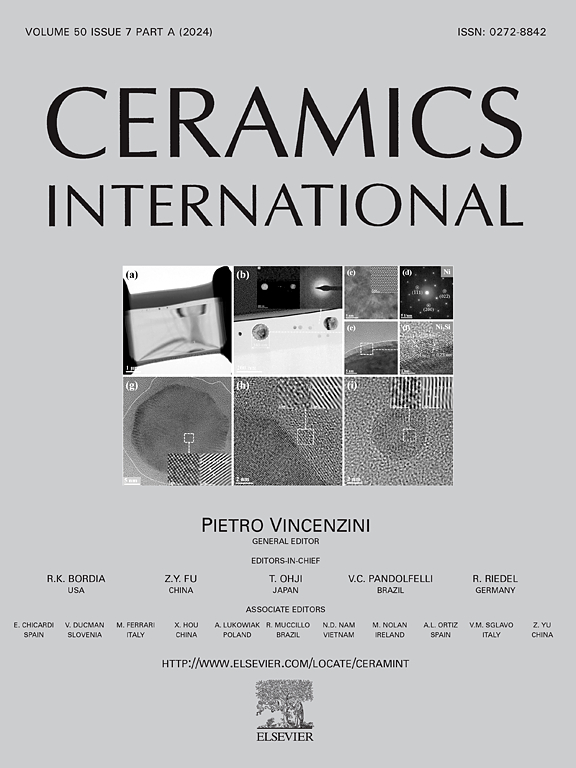Novel fast Na+ conducting rare earth-free Na5YSi4O12-type borosilicate glass-ceramics
IF 5.1
2区 材料科学
Q1 MATERIALS SCIENCE, CERAMICS
引用次数: 0
Abstract
Rare earth-free Na5RSi4O12-type sodium-ion conductive glass-ceramics (R: rare earth elements) were successfully synthesized through the crystallization of glasses using the composition Na5+xFe(BxSi4-x)O12 (x = 0–0.5). Differential thermal analysis was used to examine the glass-crystallization kinetics, providing insight into boron's effects on phase separation and its subsequent microstructural influence on the conduction properties of the glass-ceramics. The activation energy for crystal growth in Na5.2FeB0.2Si3.8O12 (x = 0.2) was determined to be 440 kJ mol−1. These glass-ceramics exhibited an ionic conductivity of 3.05 × 10−3 S cm−1 at 300 °C, with an activation energy of 48.5 kJ mol−1.
新型快速Na+导电无稀土na5ysi4o12型硼硅酸盐微晶玻璃
采用Na5+xFe(BxSi4-x)O12 (x = 0-0.5)的玻璃晶化方法,成功合成了无稀土na5rsi4o12型钠离子导电微晶玻璃(R:稀土元素)。差热分析用于研究玻璃结晶动力学,为硼对相分离的影响及其随后的微观结构对玻璃陶瓷导电性能的影响提供了深入的见解。在Na5.2FeB0.2Si3.8O12 (x = 0.2)中,晶体生长的活化能为440 kJ mol−1。这些微晶玻璃在300℃时的离子电导率为3.05 × 10−3 S cm−1,活化能为48.5 kJ mol−1。
本文章由计算机程序翻译,如有差异,请以英文原文为准。
求助全文
约1分钟内获得全文
求助全文
来源期刊

Ceramics International
工程技术-材料科学:硅酸盐
CiteScore
9.40
自引率
15.40%
发文量
4558
审稿时长
25 days
期刊介绍:
Ceramics International covers the science of advanced ceramic materials. The journal encourages contributions that demonstrate how an understanding of the basic chemical and physical phenomena may direct materials design and stimulate ideas for new or improved processing techniques, in order to obtain materials with desired structural features and properties.
Ceramics International covers oxide and non-oxide ceramics, functional glasses, glass ceramics, amorphous inorganic non-metallic materials (and their combinations with metal and organic materials), in the form of particulates, dense or porous bodies, thin/thick films and laminated, graded and composite structures. Process related topics such as ceramic-ceramic joints or joining ceramics with dissimilar materials, as well as surface finishing and conditioning are also covered. Besides traditional processing techniques, manufacturing routes of interest include innovative procedures benefiting from externally applied stresses, electromagnetic fields and energetic beams, as well as top-down and self-assembly nanotechnology approaches. In addition, the journal welcomes submissions on bio-inspired and bio-enabled materials designs, experimentally validated multi scale modelling and simulation for materials design, and the use of the most advanced chemical and physical characterization techniques of structure, properties and behaviour.
Technologically relevant low-dimensional systems are a particular focus of Ceramics International. These include 0, 1 and 2-D nanomaterials (also covering CNTs, graphene and related materials, and diamond-like carbons), their nanocomposites, as well as nano-hybrids and hierarchical multifunctional nanostructures that might integrate molecular, biological and electronic components.
 求助内容:
求助内容: 应助结果提醒方式:
应助结果提醒方式:


